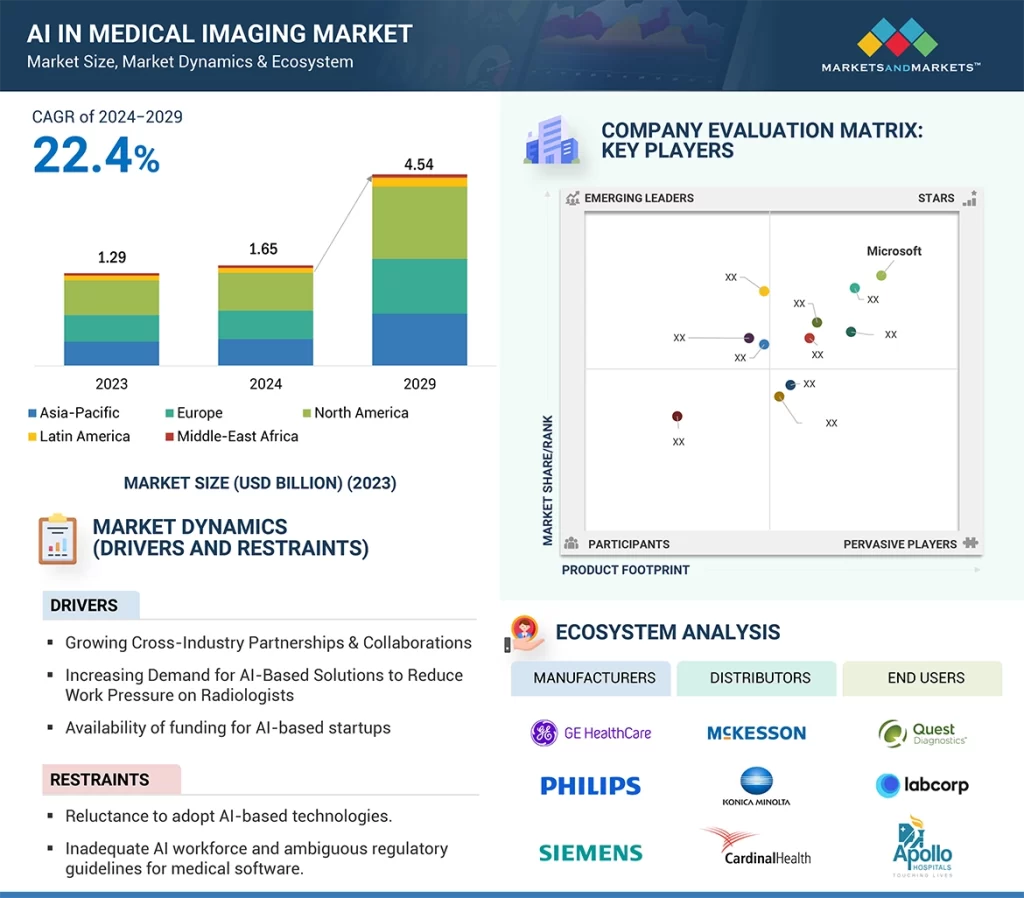The integration of Artificial Intelligence (AI) into medical imaging is revolutionizing healthcare diagnostics, offering enhanced accuracy and efficiency. As of 2024, the global AI in medical imaging market is valued at approximately US$1.65 billion and is projected to reach US$4.54 billion by 2029, growing at a Compound Annual Growth Rate (CAGR) of 22.4%. This growth is driven by technological advancements, increased funding for AI startups, and the rising prevalence of chronic diseases.

Key Market Drivers
Technological Advancements: Continuous innovations in AI algorithms and machine learning models have significantly improved the capabilities of medical imaging systems. These advancements enable more precise image analysis, facilitating early disease detection and personalized treatment plans.
Increased Funding and Investments: The surge in investments and funding for AI-based startups has accelerated the development and adoption of AI-driven diagnostic solutions. This financial support fosters innovation and expands the application of AI in medical imaging.
Prevalence of Chronic Diseases: The growing incidence of chronic diseases necessitates efficient diagnostic tools. AI-enhanced imaging provides rapid and accurate analysis, aiding in the effective management of conditions such as cancer, cardiovascular diseases, and neurological disorders.
Regional Insights
North America: This region leads the market, attributed to a shortage of radiologists, a high prevalence of chronic diseases, and substantial R&D investments in AI-driven diagnostics.
Europe: Projected to reach USD 1.54 billion by 2029, Europe exhibits a CAGR of 21.2%, driven by advancements in AI integration and supportive regulatory frameworks.
Asia-Pacific and Latin America: Emerging markets in these regions present significant growth opportunities due to expanding healthcare infrastructure and increasing adoption of AI technologies.
Challenges and Restraints
Despite the promising growth, the market faces challenges such as reluctance to adopt AI technologies, budgetary constraints, unstructured healthcare data, data privacy concerns, and limited interoperability. Addressing these issues is crucial for the seamless integration of AI into medical imaging workflows.
Growth Opportunities
Emerging Markets: Untapped regions like Latin America, Southeast Asia, and Africa offer immense potential due to their developing healthcare systems and the need for cost-effective diagnostic solutions.
Human-Aware AI Systems: Developing AI systems that align with clinician decision-making and provide interpretable, patient-centered insights can foster trust and adoption in medical settings.
Cross-Industry Collaborations: Partnerships between technology firms and healthcare providers can enhance AI algorithms, increase operational efficiency, and streamline clinical workflows.
Conclusion
The AI in medical imaging market is poised for substantial growth, driven by technological advancements, increased funding, and the pressing need for efficient diagnostic tools. Stakeholders must navigate challenges and leverage growth opportunities to fully realize the potential of AI in transforming healthcare diagnostics.
